MARIANI’S
Virtual Gourmet
September
2, 2018
NEWSLETTER
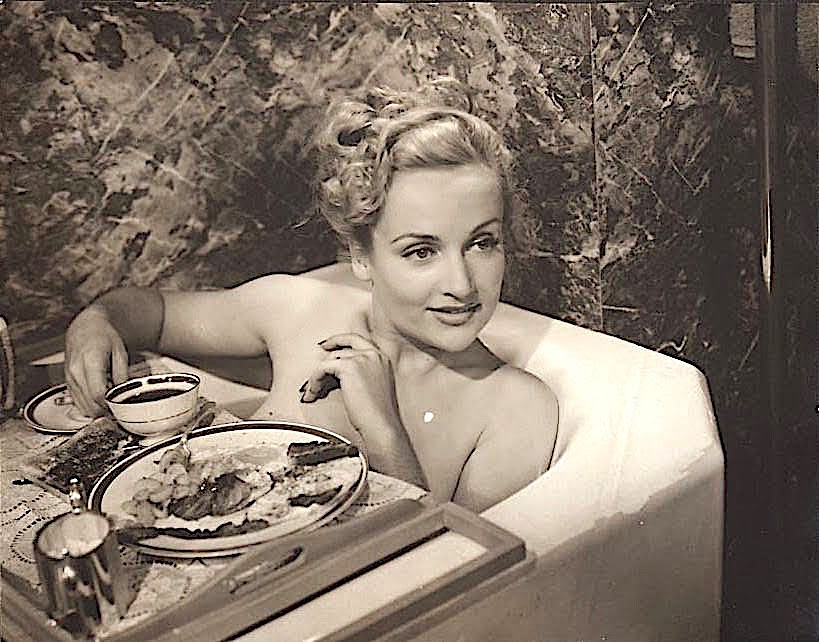
❖❖❖
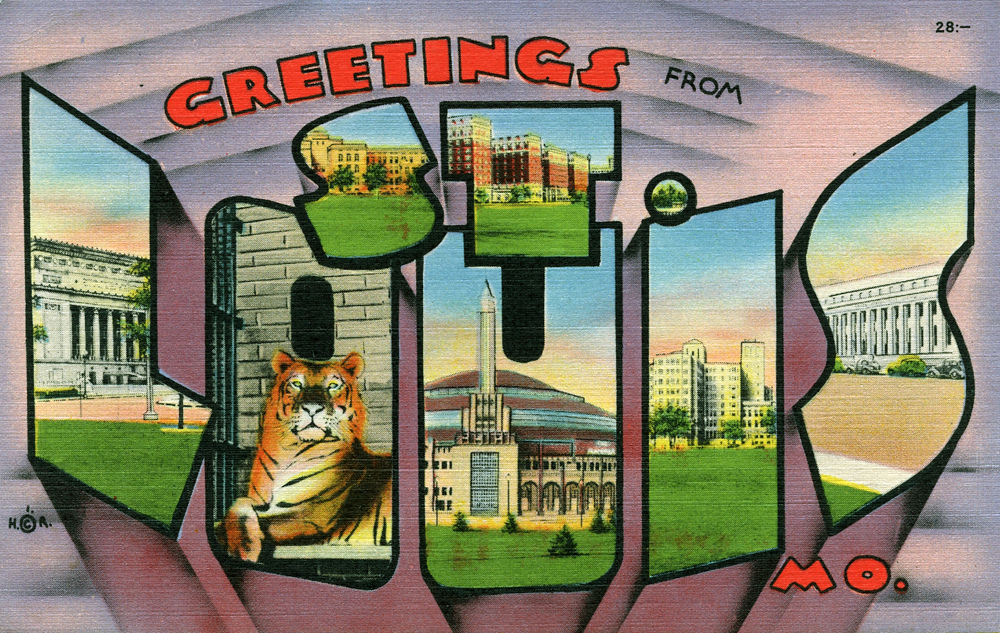
ANNOUNCEMENT: There will be no issue of Mariani's Virtual Gourmet next weekend because Mariani will be visiting and dining around St. Louis, Missouri, on behalf of his readers.
❖❖❖
IN THIS ISSUE
THE INN AT LITTLE WASHINGTON
By John A. Curtas
JAMES VILLAS, ONE OF AMERICA'S
GREAT FOOD WRITERS DIES AT AGE 80
By John Mariani
NEW YORK CORNER
BOBBY VAN'S STEAKHOUSE
By John Mariani
NOTES FROM THE WINE CELLAR
MONDAVI WINES
By Andrew Chalk
❖❖❖
THE INN AT LITTLE WASHINGTON
By John A. Curtas
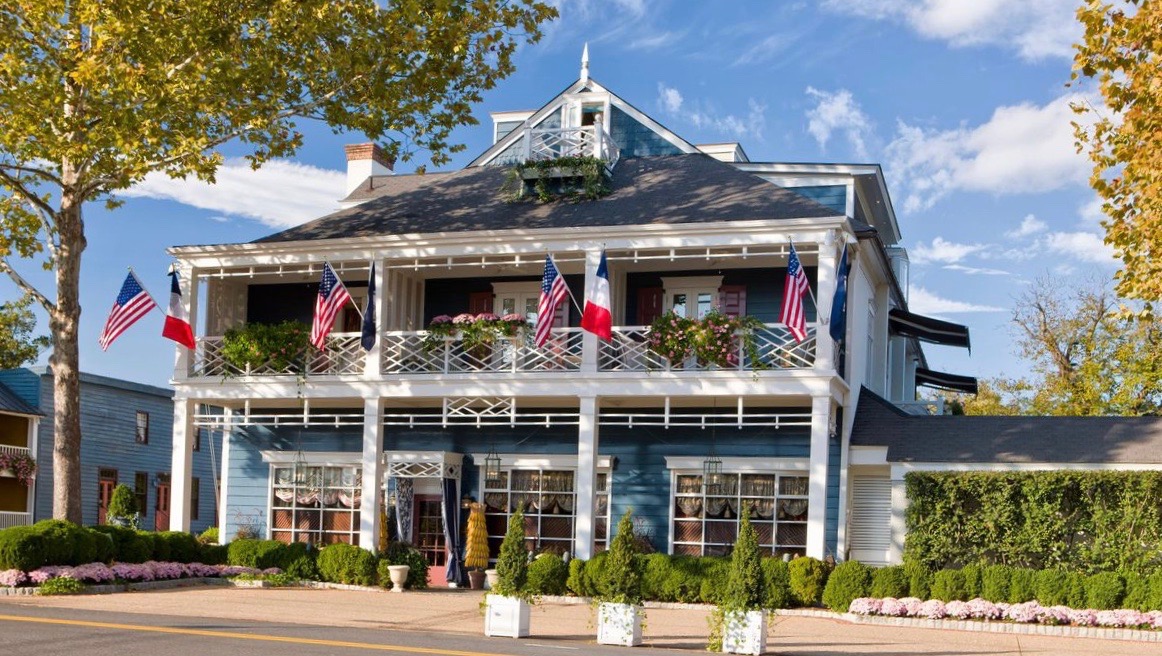
I am not a patient
man. In my world, immediate
gratification takes too long. Yet it took me
forty years to get to The Inn at
Little Washington. Forty years of reading about
it, contemplating its
fabulousness and kicking myself for not taking
the time to journey an hour west
of Washington, D.C., to sample the cuisine of
Patrick O'Connell (right). To be
accurate, with D.C. traffic being what it is,
the drive can easily take two
 hours.
Perhaps that has had something to do with it.
hours.
Perhaps that has had something to do with it.
Accolades
have been never-ending over that time—Five
Diamonds from the AAA; five stars
from Mobil (now Forbes); two Michelin stars, more
Wine Spectator awards than you can
count; best restaurant in the
Washington D.C. area seemingly forever; cooking
for Queen Elizabeth—you know,
the usual for a small country caterer who made
good in a town of 158 people.
Sometimes a
whole decade would pass off my radar, then I'd
pick up some food or travel
magazine and there it would be, accepting medals
and beckoning again—one man's
very particular vision of luxury; a chef's fantasy
come to life of what the
ultimate in American fine dining could be.
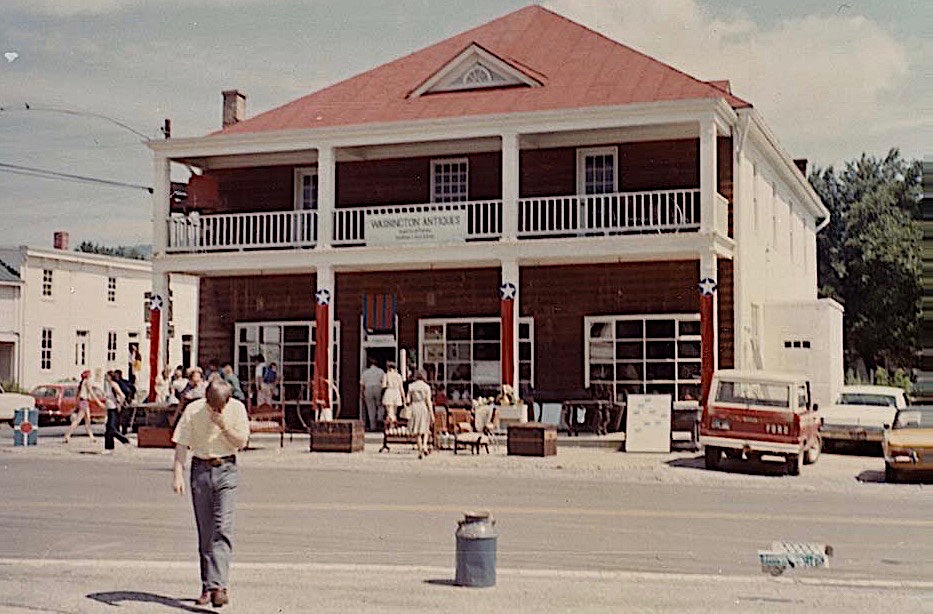 What
O'Connell
started in 1978 began rather modestly, at a time
when Alice Waters
and Jeremiah Tower were taking the West Coast by
storm with their farm-to-table
renaissance, and New York’s Le Cirque was defining
the ne plus ultra of big
city dining.
Operating out of a
converted gas station O'Connell and his then
partner, Reinhardt Lynch, decided
to convert their catering business into a country
inn. They were definite
Francophiles in the Tower/Waters mold, but where
Chez Panisse was a bunch of
hippies cooking great food in a college town,
theirs was a more proper
sensibility. The linens were starched and the
place settings were just so. Thus
it remains to this day, and the attention to
detail makes the place as
different from Chez Panisse as Judy Dench is from
Joan Baez. But that
starchiness fades as soon as you approach the
doorway. The formality of the
premises may be set to impress, but the welcome is
as warm and sweet as shoo fly
pie.
What
O'Connell
started in 1978 began rather modestly, at a time
when Alice Waters
and Jeremiah Tower were taking the West Coast by
storm with their farm-to-table
renaissance, and New York’s Le Cirque was defining
the ne plus ultra of big
city dining.
Operating out of a
converted gas station O'Connell and his then
partner, Reinhardt Lynch, decided
to convert their catering business into a country
inn. They were definite
Francophiles in the Tower/Waters mold, but where
Chez Panisse was a bunch of
hippies cooking great food in a college town,
theirs was a more proper
sensibility. The linens were starched and the
place settings were just so. Thus
it remains to this day, and the attention to
detail makes the place as
different from Chez Panisse as Judy Dench is from
Joan Baez. But that
starchiness fades as soon as you approach the
doorway. The formality of the
premises may be set to impress, but the welcome is
as warm and sweet as shoo fly
pie.
The design
might be called Downton Abbey meets Colonial
Williamsburg, with more than a
touch of English flamboyance, which makes sense
when you learn it was done by a
British stage set designer. Chintz, portraiture
and floral prints are
everywhere, so much so that you'll want to break
out your hunting jacket and
jodhpurs.
Everyone is
all smiles as you approach and every guest, even
the regulars, seems to soak up
and bask in the special-ness of the place. The
decor may be over-the-top
Anglophile but the cuisine is resolutely French,
and what is so astonishing is
how O'Connell—a chef with no formal training—has
been able to evolve with the
times and present a menu that is both classic and
modern.
Perfect, warm
bread is served as soon as you order. The butter
is the right temperature and
just soft enough, barely resistant to your knife,
an immediate indication that
someone in the kitchen is paying attention to the
smallest details. Amuse bouches
are offered, and whatever
shows up will take your breath away. Does a
gougère get more spherical or
precise? Can a cold artichoke soup be anymore
intense? Oysters come with a
quartet of frozen fruit "slushie" scoops -- each
one a sweet and
acidic counterpoint to the briny mollusk beside
it.
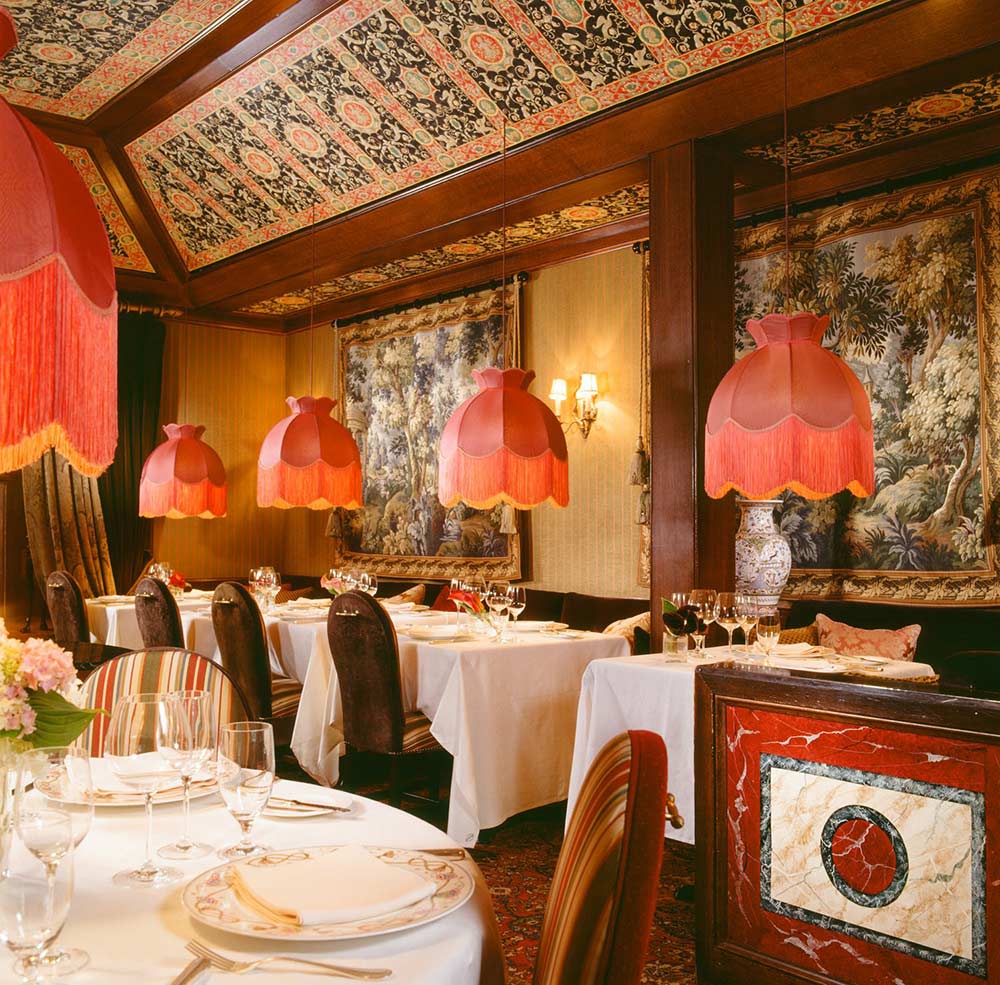 No matter what menu you
order from—“Enduring
Classics," "Gastronauts," or "The Good Earth”—you
can be
assured of four exquisite courses for a set price
of $228 per person ($238 on Saturday) and $15 for
wine pairings, but it’s
really more like six to eight dishes once all the
amuses and various edible doodads
are thrown in. Besides those
Wellfleet oysters, each as plump and briny as this
shellfish can get, the
Classics menu brings forth a carpaccio of
herb-crusted Elysian Fields lamb loin—nine
medallions of magenta-colored raw lamb upon which
sit three scoops of
"Caesar Salad Ice Cream" (below). The ice cream is
flavored with garlic and
Parmesan, and once you get past the surprise, you
realize it is simply a
cheese-infused aïoli in a frozen, emulsified
guise. This is O'Connell playing
with his food (and keeping up with the times), but
he does so without
affectation and with a firm sense of flavor.
No matter what menu you
order from—“Enduring
Classics," "Gastronauts," or "The Good Earth”—you
can be
assured of four exquisite courses for a set price
of $228 per person ($238 on Saturday) and $15 for
wine pairings, but it’s
really more like six to eight dishes once all the
amuses and various edible doodads
are thrown in. Besides those
Wellfleet oysters, each as plump and briny as this
shellfish can get, the
Classics menu brings forth a carpaccio of
herb-crusted Elysian Fields lamb loin—nine
medallions of magenta-colored raw lamb upon which
sit three scoops of
"Caesar Salad Ice Cream" (below). The ice cream is
flavored with garlic and
Parmesan, and once you get past the surprise, you
realize it is simply a
cheese-infused aïoli in a frozen, emulsified
guise. This is O'Connell playing
with his food (and keeping up with the times), but
he does so without
affectation and with a firm sense of flavor.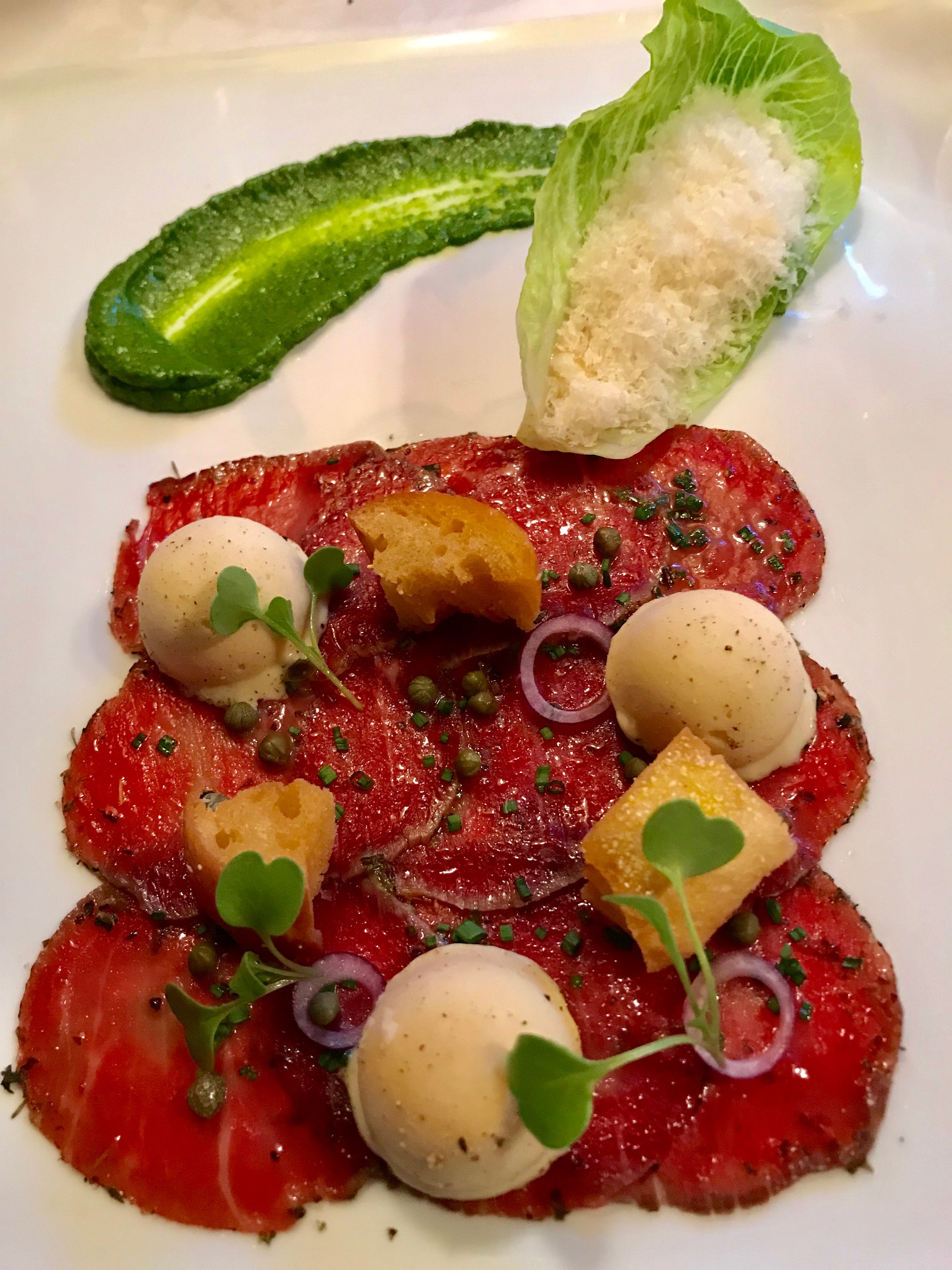
More
classically rooted is the duet of bread-crusted
rabbit loin with braised
chestnuts, apples, and prunes, highlighted by the
sort of dense, rich reduction
sauce that makes you wish they served it by the
spoonful. Following on the
Classics menu was Pekin Duck Three Ways—pan-seared
breast, sausage and confit—served
on sparkling sauerkraut that would do an Alsatian
proud.
On the "Gastronauts"
side, things lighten up a bit,
featuring the season's first white asparagus
poached in cream, and presented
with a dollop of Royal Osetra caviar, followed by
foie gras with port-soaked
raisins atop a rich, savory Catalan custard, and
then a simple rectangle of
grilled marlin decorated with peeled grapes and a
curried hollandaise.
This
is not cartwheels-in-the-kitchen
cooking, but the rendition of each dish was as on
point as French food can be.
Of all the main dishes though, the one that got
our attention was a simple
parsley-topped, very rare lamb loin, served with a
crêpinette of lamb merguez sausage (below),
presented like a lollipop at
the end of a rib bone. It was elegant yet simple,
minimalist and precise and
gave the slightest of nods to modernist cuisine
without giving in to the
absurdity of so much of it.
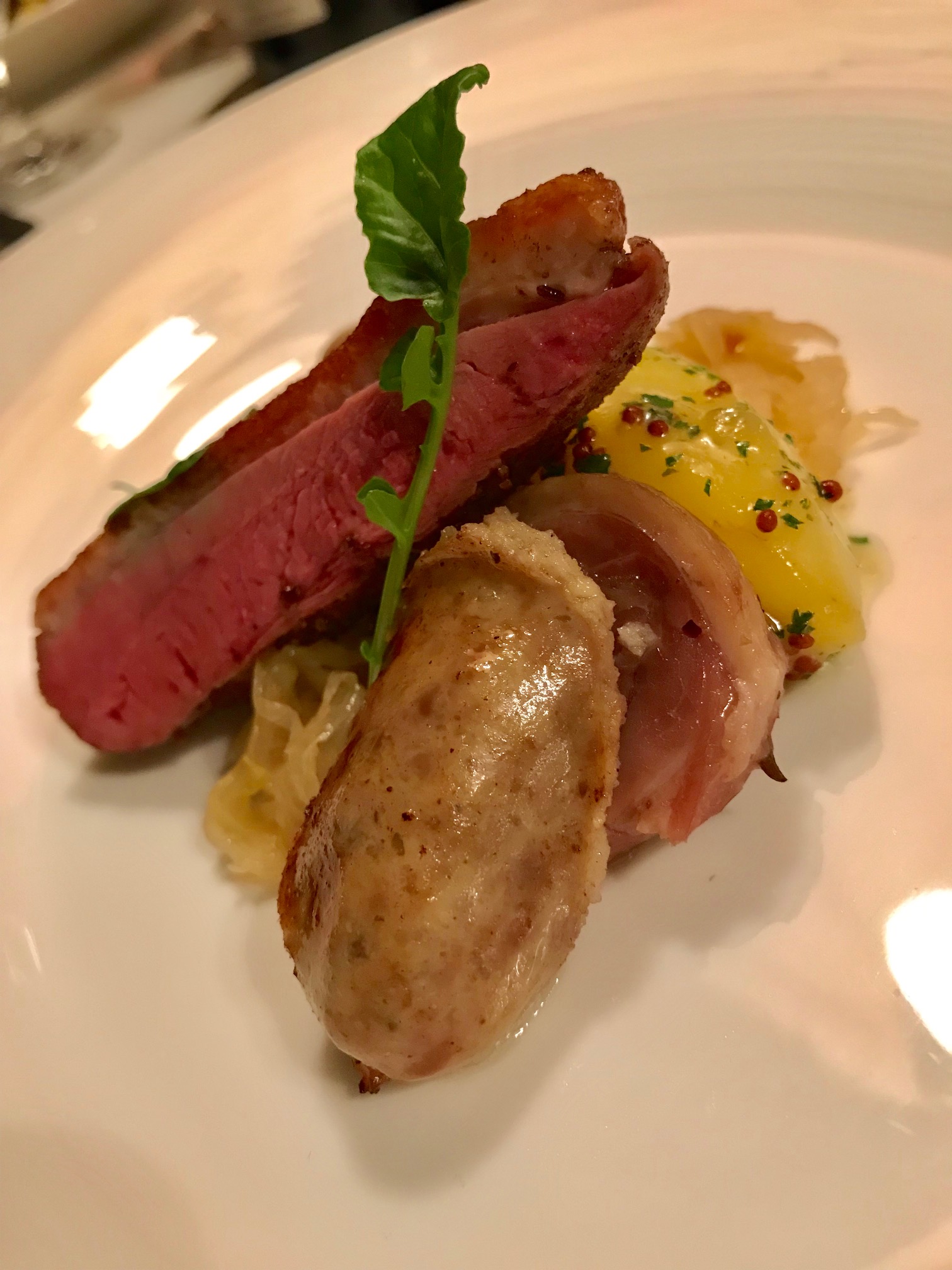 A single
meal, forty years into a restaurant's run, hardly
gives one the depth of knowledge needed to
summarize a chef's
cooking. But my evidence told me O'Connell takes
great pride in his proteins
and that he has almost perfect pitch when it comes
to letting ingredients
express themselves. As with all accomplished
French chefs, it is the marriage
of great food and wine that informs his dishes.
A single
meal, forty years into a restaurant's run, hardly
gives one the depth of knowledge needed to
summarize a chef's
cooking. But my evidence told me O'Connell takes
great pride in his proteins
and that he has almost perfect pitch when it comes
to letting ingredients
express themselves. As with all accomplished
French chefs, it is the marriage
of great food and wine that informs his dishes.
And, as with
the great, long-lived restaurants of France, a
broad, carefully collected wine
cellar is at your disposal. Choosing those wines
will take some time though,
since the 81-page list is a trove of name brand
bottles and obscure offerings.
High rollers will enjoy all the big hitter
verticals of Burgundy, Bordeaux and
Napa at the usual choke-a-horse prices, while mere
mortals will have a field
day matching this wine-friendly food with plenty
of selections under $100. If
you're willing to venture into the world of
Rieslings and Italian whites, there
are bargains aplenty.
Markups for
non-trophy reds run in the range of 100-200% over
retail, which is modest by
destination dining standards. Corkage is charged
at $50 for your first bottle
and $75 for the second, but they happily waive the
charge if you purchase at
least one bottle (at any price) from their list.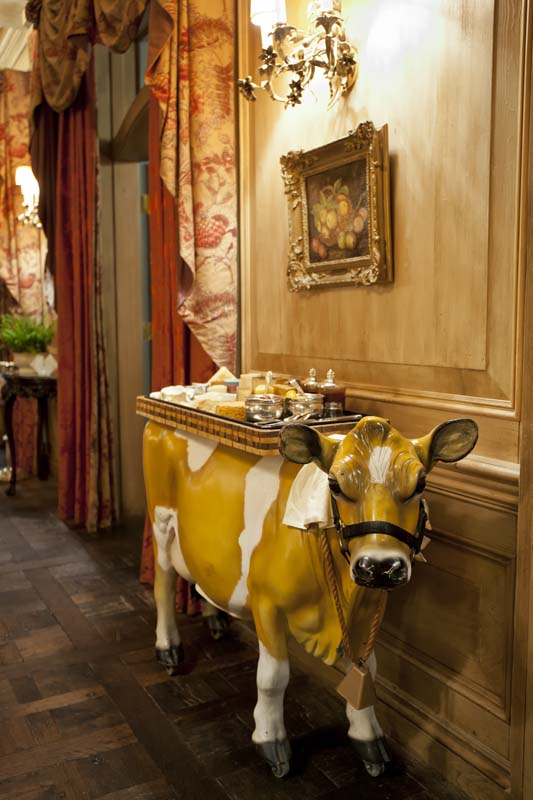
Much is made
of the cheese cart and the attendant puns like,”
You won't Brie-lieve our
selection." "Havarti had that one?" But the array
is impressive
and all cheeses are served at peak ripeness. The
fact that they’re
presented on a rolling ceramic cow cart
that even moos only adds to the cheesiness of the
presentation. It all might be
a bit much for the over-serious epicure, but I was
rather fondue of it.
Desserts are
more soothing than surprising. There's no faulting
the warm Granny Smith apple
tart with buttermilk ice cream, or the lemon
tartlet. The one curiosity, “Apparently
A Pear," disguises a bracing blackberry sorbet
beneath a golden meringue
crust, the whole ornament bathed with a warm,
melting sabayon that dissolves
the crunchy exterior and any remaining resistance
you have to the old-fashioned
charms of the place.
Along with
great food and wine, it is that charm and comfort
that The Inn at Little
Washington has been selling since January 28,
1978. There is a soothing quality
to a meal here that very few, if any, restaurants
in America try to duplicate.
You are cosseted from the moment you approach the
front door until you bid
adieu three hours later. In this era of bare
tables, pin lights, interminable
tasting menus, Instagrammable dishes and
media-strutting chefs, it is a
throwback in all the best ways. And it seems the
qualities it brings to the
table are now captivating a third generation of
diners.
On the
weeknight we ate there, Gen-Xers and Millennials
outnumbered the aging Baby
Boomers in the very full dining rooms.
Hospitality like this never goes
out of style, and it won't be another forty years
before this aging Boomer
experiences it again.
The Inn at
Little Washington's guest accommodations, is
open every evening except Tuesdays.
JAMES VILLAS, ONE OF AMERICA'S
GREAT FOOD WRITERS, DIES AT AGE 80
By John Mariani
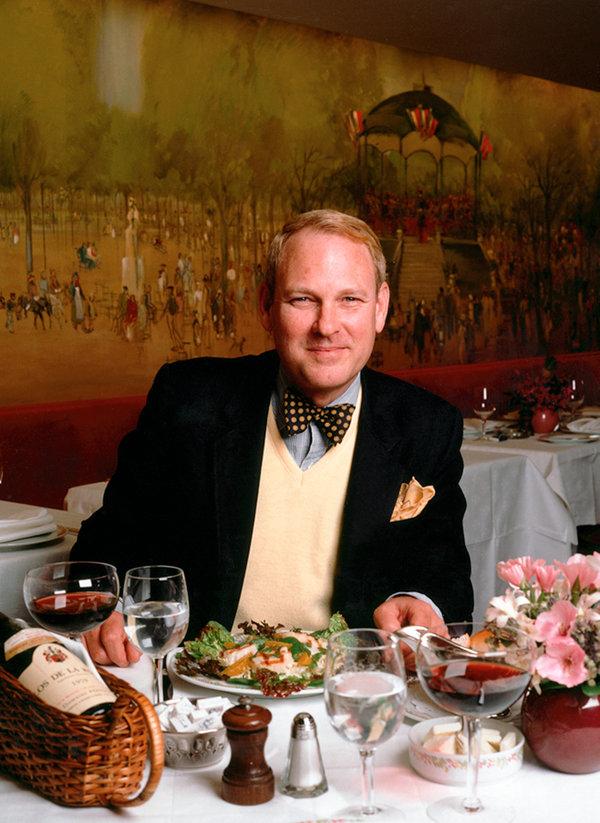
James Villas at La Caravelle, NYC (circa 1985)
I am
very sad to hear that my friend and
colleague James Villas has passed away at his
East Hampton, N.Y., home at the
age of 80. Erudite, whip smart, hilarious and
doggedly Southern, he was one of
the finest food and travel writers in America
for six decades. His staunch
standards, though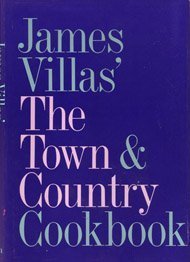 open to debate,
were all his own and he did not suffer fools
lightly. To know Jim was to know a unique
personality in a food world filled
with so many minor talents who only wish they
had Jim's experience and style.
open to debate,
were all his own and he did not suffer fools
lightly. To know Jim was to know a unique
personality in a food world filled
with so many minor talents who only wish they
had Jim's experience and style.
Proudly a son of the South, Jim was born in Charlotte, N.C., where his grandfather ran a diner and his mother had a reputation as one of the best cooks in the area. He traveled and dined widely with his parents, falling in love with Transatlantic ship crossings—for a long while he made annual trips on one of the Cunard liners—and eventually authored 12 cookbooks, many award winning, three with his mother.
Jim’s original intention, after earning a PhD., was to teach French literature, which he did at the University of Missouri and Rutgers, but the acceptance by Esquire magazine of an article he wrote catapulted him into becoming a gourmand and food writer, when such journalism was off-handed and stultified. “When a certain moment arrived in life that demanded making a career choice,” he wrote, “I opted for Lucullus over Flaubert.”
Esquire
hired him as an assistant editor and he then
gained a sinecure at Town
& Country that lasted until
1999, during a period when magazines were
flush with money and their writers
had flagrantly generous expense accounts. Yet,
despite his love for haute
cuisine, Parisian temples of gastronomy and
Edwardian tables in London, Jim’s
enduring love and crusade was for Southern
food, of which he said, “Our
style of cooking has served not
only as a focus of our lives but as a
veritable symbol of survival.” 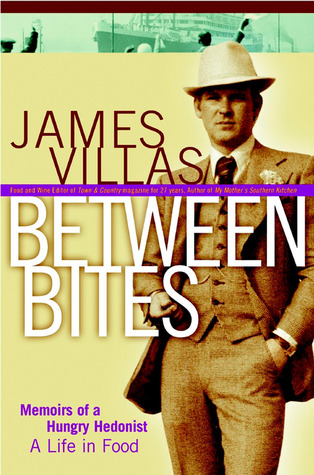
He became a standard-bearer for both haute cuisine and regional America fare simultaneously, which by the 1990s made him into something of a curmudgeon. “I much prefer the company of an expert pig breeder or hungry whiskey distiller to that of a fatuous foodie waxing ecstatically about Peruvian peppers or some young hot-shot chef’s latest fusion concoctions.” As a good Southerner, he once said, “Don’t pee on my leg and tell me it’s raining.” Yet, as a stylist, few had his swagger and fewer still his experience.
Indeed,
his loathing for the so-called New American
Cuisine eventually became bombast,
dismissing its cooks as “children playing in
the sandbox.” Jim’s refusal to shy
away from that belief ultimately made him seem
passé in the eyes of a new
generation of chefs and food writers who were
turning their backs on everything
Jim stood for. It took a decade for them to
catch up and embrace what Jim had been one of
the first to champion—Southern
cooking.
I first met Jim back in the 1970s at one of his favorite restaurants in New York, Larry Forgione’s An American Place, and my first reaction was that this couldn’t be Jim Villas, whose writing in Esquire suggested he’d been a corpulent bon vivant for half a century. Yet here was this handsome, very blond, impeccably dressed fellow in his thirties, who turned out to be anything but the old fogy I’d expected.
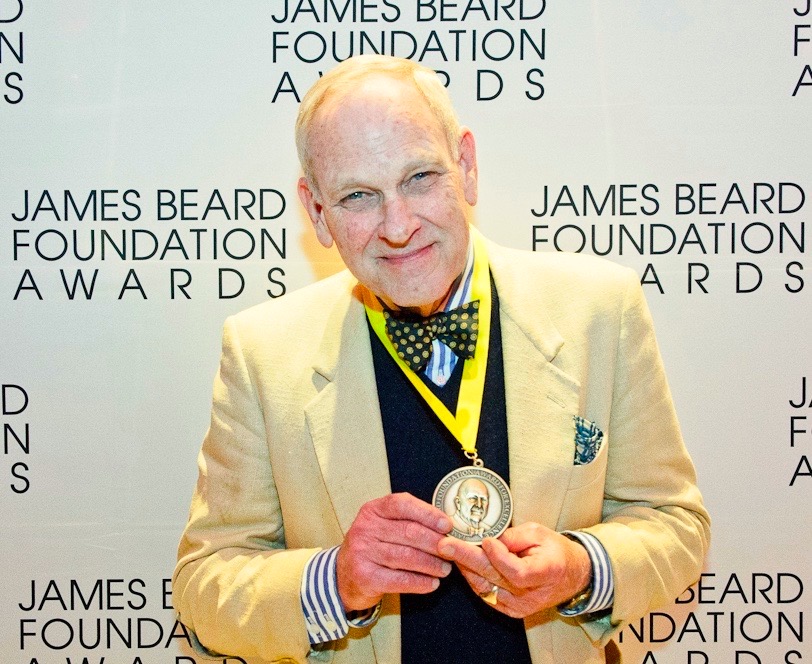 Jim
and I dined out together now and then, and,
with my wife Galina at the table
(he put us as a couple in his novel Dancing
in the Low Country), we would talk
endlessly about food and culture, kibitz
and gossip, drink good wines and laugh
throughout the evening. When no smoking
laws went into effect, Jim actually refused to
dine out for a good while,
though he later told me, “John, do everything
you can to keep your children
from smoking.”
Jim
and I dined out together now and then, and,
with my wife Galina at the table
(he put us as a couple in his novel Dancing
in the Low Country), we would talk
endlessly about food and culture, kibitz
and gossip, drink good wines and laugh
throughout the evening. When no smoking
laws went into effect, Jim actually refused to
dine out for a good while,
though he later told me, “John, do everything
you can to keep your children
from smoking.”
No one was a better raconteur and he used his deep Southern drawl as a crooner would singing a ballad. After his retirement from magazine writing, Jim confessed disillusionment with what was going on in food journalism and trendiness in food generally. He suffered a stroke about ten years ago, which slowed him down physically but certainly not mentally. He was as sharp witted as ever and as passionately committed to his belief that “common sense” must guide cooking.
“Some labels I gladly take on,” he said. “Elitist, proudly. Hedonist, assuredly. Both describe not only my wanton, unbridled approach to gastronomy in general but the way I’ve cultivated lasting relationships only with those whom I consider to be extraordinary people.”
It’s funny, but I never recall Jim frowning. He was too busy being elated, acting the Southern gentleman, always eager for a good-natured argument, and, as they say in the South, “Grinnin’ like a possum eatin’ a sweet potato.”
He was an extraordinary person.
By John Mariani
BOBBY VAN'S STEAKHOUSE
"The Original"
230 Park Avenue (at 46th Street)
212-867-5490
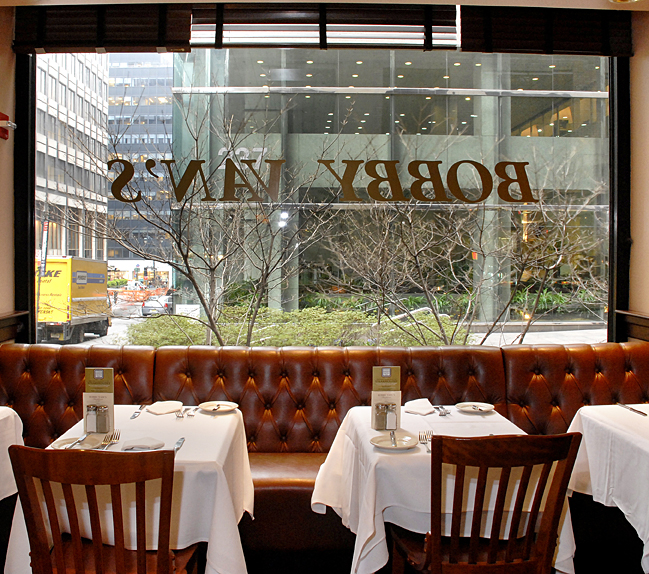
It is absurd for the food media to assert that all steakhouses have pretty much the same menu and therefore do not deserve attention. Fact is, the menus at the majority of restaurants of any stripe have more or less the same menus. There will always be burrata and tomatoes on the Italian, onion soup gratinée on the French, pad thai noodles on the Thai, chicken quesadillas on the Mexican, and lamb vindaloo on the Indian. The only real question is: who makes those standards best and what variations and specials might there be?
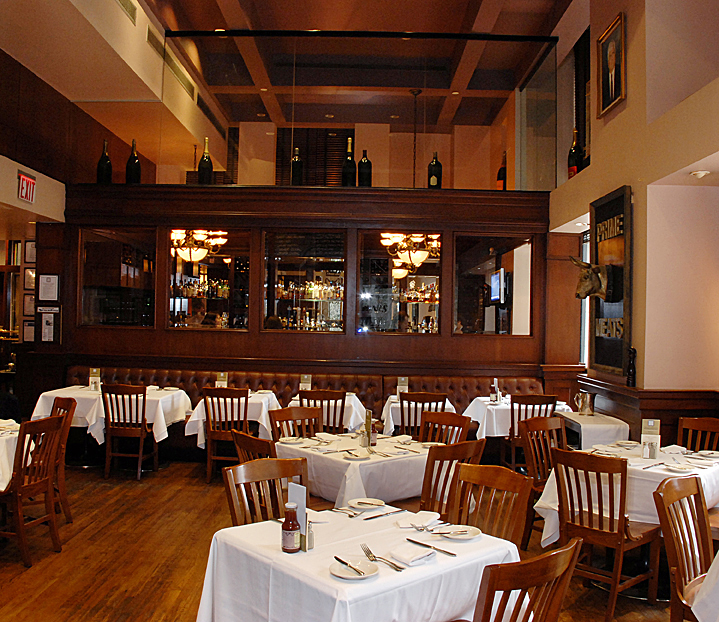 Bobby Van’s
seems to be doing what it does with
an unwavering consistency that has kept its
business thriving for 49 years. It
all began when a fellow named Bobby Van opened a
restaurant in Bridgehampton on
Long Island. Two decades later Van sold that
restaurant to
Rick
Passarelli, who opened a second Bobby Van’s
Steakhouse, tucked
into a corner of Park Avenue and 46th Street, just
north of Grand Central
Terminal. In 1996 restaurateur and
chef
Robert Dickert, a great-nephew of Peter Luger,
joined Bobby Van’s team and
helped expand from the Park Avenue “original” to
five steakhouses in Manhattan, one
at JFK airport and two in Washington, DC.
Bobby Van’s
seems to be doing what it does with
an unwavering consistency that has kept its
business thriving for 49 years. It
all began when a fellow named Bobby Van opened a
restaurant in Bridgehampton on
Long Island. Two decades later Van sold that
restaurant to
Rick
Passarelli, who opened a second Bobby Van’s
Steakhouse, tucked
into a corner of Park Avenue and 46th Street, just
north of Grand Central
Terminal. In 1996 restaurateur and
chef
Robert Dickert, a great-nephew of Peter Luger,
joined Bobby Van’s team and
helped expand from the Park Avenue “original” to
five steakhouses in Manhattan, one
at JFK airport and two in Washington, DC.
Under Executive Chef Craig Jermin, the USDA Prime beef is aged in a specially designed, humidity-controlled room for up to 28 days. For seafood Bobby Van’s has a fleet of 30 fishing boats providing the freshest fish and shellfish daily.
All that history gives Bobby Van’s enormous purchasing clout, and it shows in the quality of the ingredients and in the way they are cooked. For no good reason, I had never actually eaten at “the original,” though I’ve enjoyed others in the chain, so I made up for that lapse recently and enjoyed myself from the moment I was greeted to the last mouthful of cheesecake.
The various locations share a certain décor,
and though oddly configured as a room, the Park
Avenue restaurant is very
handsome via an expansive use of mahogany wood,
polished floors, very sturdy,
comfortable wooden chairs, warm lighting,
tablecloths you don’t even notice
because you expect them in a good steakhouse, and,
even when full, a space in
which you can easily have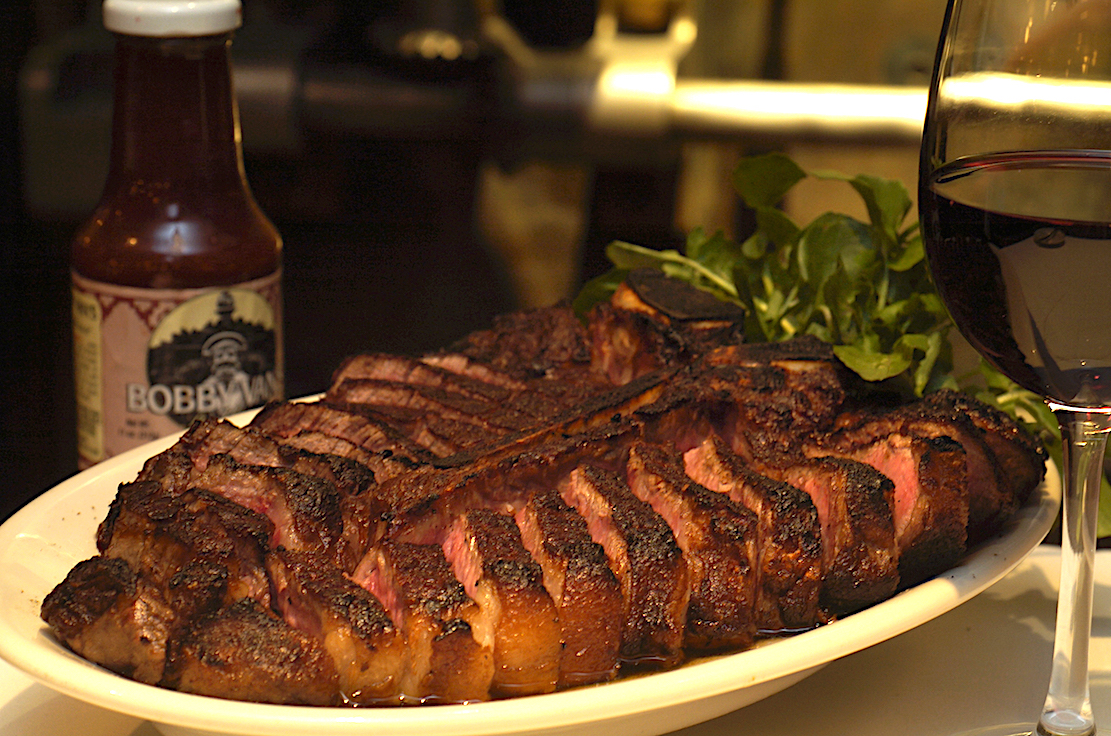 a conversation.
No music blares in the background. A bottle
of pretty good house steak
sauce is on every table.
a conversation.
No music blares in the background. A bottle
of pretty good house steak
sauce is on every table.
A word about the service staff: As in many other New York steakhouses, there’s a good possibility that the waiters will have come from eastern Europe, particularly the former Yugoslavian republics. Overall, I’ve found that those at the Bobby Van’s restaurants have a jaunty demeanor, happy to speak with you about any subject under the sun. Ours, long ago from Montenegro, was named Sam Pejcinovic, and I wish he could be cloned at every branch. Affable, jovial and very knowledgeable, he took every request seriously and had the pacing of the meal down to a science. If he asks if everything is to your liking, he does it in a tone that suggests he’ll fix any little thing that’s wrong in a New York minute.
You begin with four different types of good bread and a large ramekin of spreadable butter. Cocktails are made as requested.
The massive two-inch thick
sirloin ($63) I
ordered “black and blue” did indeed come rare and
cool inside and had plenty of
aged beef flavor. A double veal chop ($52) was of
superb tenderness and had
rich taste, well seared on the outside and bone.
Other cuts include filet
mignon ($48 and $58) and the porterhouse for two
or more goes for
$59.50 per person. I should note that these
prices are higher than at most of BV's
competitors.
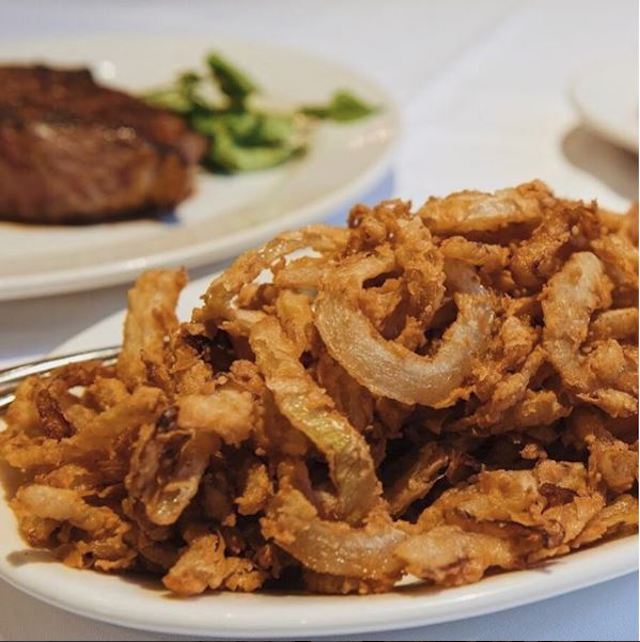 If a sushi
restaurant should be defined by its
impeccable seafood, so, too, should a steakhouse
serving oysters, crab, clams,
lobsters and fish. In that regard, a crabcake is
always a good measure of a
steakhouse’s commitment. Bobby Van’s is a
good-sized patty with minimal
filler, just
enough mayonnaise to
bind it, and plenty of sweet crabmeat, though it
would have been even better,
especially at $24, had it been jumbo lump meat. Lemon pepper shrimp ($24.50)
were, on the other hand, pretty
big creatures with plenty of meatiness.
If a sushi
restaurant should be defined by its
impeccable seafood, so, too, should a steakhouse
serving oysters, crab, clams,
lobsters and fish. In that regard, a crabcake is
always a good measure of a
steakhouse’s commitment. Bobby Van’s is a
good-sized patty with minimal
filler, just
enough mayonnaise to
bind it, and plenty of sweet crabmeat, though it
would have been even better,
especially at $24, had it been jumbo lump meat. Lemon pepper shrimp ($24.50)
were, on the other hand, pretty
big creatures with plenty of meatiness.
There was no arguing about the quality and preparation of the thee-pound lobster (MP), however. It was steamed to perfection—I can’t remember a better lobster anywhere in New York—its shell cracked by Sam, the meat then removed from the shell at the table, assuring it would not get cold on the platter. The amount of that meat in the tail and claws was impressive, and the amount of melted clarified butter was enough to drown a gallon of mashed potatoes. There was a good briny flavor to the crustacean, and its texture was not chewy in the least.
I’ve long been a sucker for a classic American
wedge salad, and Bobby Van’s is nonpareil
($17.50)—the lettuce very crisp, the
bacon, blue cheese and dressing tangy and salty,
with a crusty lagniappe of
fried onions on top, all of it presented in a
portion that two
or three diners could
share. Just as good was a side of creamed spinach
in which the vegetable was
not overwhelmed by the cream or seasoning. Sam recommended the hash
browns over other options and he
was right. Very buttery and clearly prepared not
long in advance, they were the
perfect accompaniment to the meat and lobster.
that two
or three diners could
share. Just as good was a side of creamed spinach
in which the vegetable was
not overwhelmed by the cream or seasoning. Sam recommended the hash
browns over other options and he
was right. Very buttery and clearly prepared not
long in advance, they were the
perfect accompaniment to the meat and lobster.
Despite the satisfaction of such a meal thus far, desserts like New York cheesecake, chocolate cake and a tall tiramisù hit the spot.
Bobby Van’s wine list has enough trophies among its mainly French and Italian bottlings, and prices are as steakhouse high as everywhere else.
I was, therefore, happy to get to “the original” Bobby Van’s, not only to add it to my files but to remind me that, as at the other branches, I could be blindfolded and served the same meal and enjoy it every bit as much. Of course, I might miss Sam Pejcinovic to kibitz with, but there’s probably others him like him throughout the Bobby Van’s empire.
Open Mon.-Fri. for lunch and dinner, Sat. for dinner. Closed Sunday.
❖❖❖
ROBERT
MONDAVI RESERVE
AND
TO KALON VINEYARD:
A RETROSPECTIVE AND CELEBRATION
By Andrew Chalk
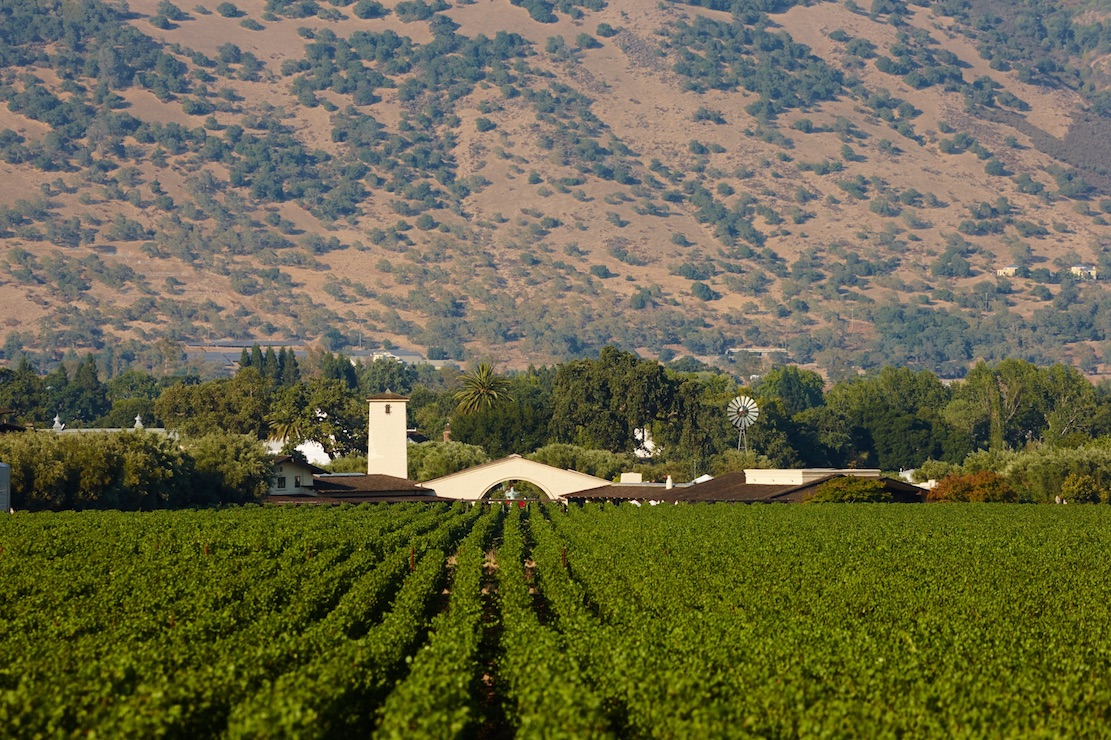
 To
celebrate and give
context to the Robert Mondavi Reserve Cabernet
Sauvignon, the winery put
together one of the most elaborate and
comprehensive tastings of a wine that I
have ever attended. For an audience made up of
the cream of sommeliers and
retail partners in Napa the winery
orchestrated a four-stage event, punctuated
by Krug Champagne and To Kalon Fumé Blanc
interludes. To interest and intrigue
the tastings were blind.
To
celebrate and give
context to the Robert Mondavi Reserve Cabernet
Sauvignon, the winery put
together one of the most elaborate and
comprehensive tastings of a wine that I
have ever attended. For an audience made up of
the cream of sommeliers and
retail partners in Napa the winery
orchestrated a four-stage event, punctuated
by Krug Champagne and To Kalon Fumé Blanc
interludes. To interest and intrigue
the tastings were blind.
First was a flight of eight
glasses, each filled with a taste of a deep
red wine. As the dozens of
assembled tasters worked through them there
were perplexed expressions and
delight, the
former from the
heterogeneous flavors, tastes and characters
of the wines, the latter from the
joy of being on this journey of discovery.
Everyone felt the flight had been an
education when Mark de Vere, Director and
Master of Wine at Constellation
Academy of Wine, revealed them to be a global
flight of Cabernet Sauvignon
wines:
• 2015 Château d’Issan, Margaux,
3ème Cru Classé, Bordeaux.
• 2015 Mollydooker Gigglepot
Cabernet Sauvignon, McLaren Vale,
South Australia
• 2015 Robert Mondavi Winery
Cabernet Sauvignon, Napa Valley
• 2014 Justin Isosceles, Paso
Robles
• 2014 Col Solare Cabernet
Sauvignon, Red Mountain, Washington
State
• 2014 Mount Veeder Winery
Reserve, Mount Veeder, Napa Valley
• 2014 Robert Mondavi Winery
Cabernet Sauvignon, Oakville, Napa
Valley
• 2013 Inherit the Sheep Cabernet
Sauvignon, Coombsville, Napa
Valley
The flight was split by rows
with the 2015s tasted together, then the
earlier flight. De Vere explained to
me that the design of the flight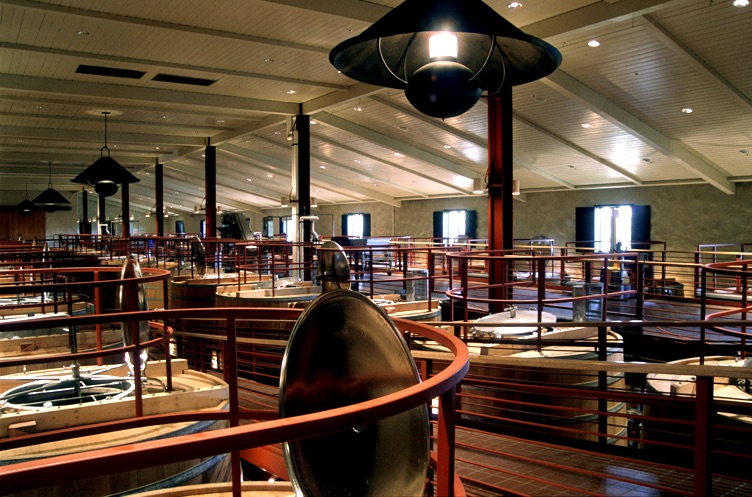 was
to contrast the styles of the grape. My
personal impressions were that it was easy
picking out the Bordeaux (the cedar
signature) and the Napa wines, but I needed to
work on the rest.
was
to contrast the styles of the grape. My
personal impressions were that it was easy
picking out the Bordeaux (the cedar
signature) and the Napa wines, but I needed to
work on the rest.
After a few sips of Krug
Grand Cuvée Brut we tasted a second flight
designed to show the distinctive
style of To Kalon vineyard.
• 2012 Château Margaux, Margaux,
Premier Grand Cru Classé,
Bordeaux.
• 2015 Penfolds Bin 707 Cabernet
Sauvignon, South Australia
• 2013 Robert Mondavi Winery
Cabernet Sauvignon Reserve, To Kalon
Vineyard, Oakville, Napa Valley
• 2014 Paul Hobbs Cabernet
Sauvignon Beckstoffer, To Kalon
Vineyard, Oakville, Napa Valley
• 2013 Shafer Hillside Select
Cabernet Sauvignon, Stags Leap
District, Napa Valley
 The
Robert Mondavi Reserve
exhibited a nose of sawdust and cigar box,
with chewy tannins in the mouth and
flavors of raspberry. It had the most grip out
of this flight, portending a
long life.
The
Robert Mondavi Reserve
exhibited a nose of sawdust and cigar box,
with chewy tannins in the mouth and
flavors of raspberry. It had the most grip out
of this flight, portending a
long life.
During
our afternoon break
we had a presentation on the history of To
Kalon while we sipped on 2015 Robert
Mondavi Winery Reserve Fumé Blanc, To Kalon
Vineyard, Oakville, Napa Valley.
Finally,
no Cabernet
Sauvignon can claim to be world class if it
does not age. The last flight
soundly knocked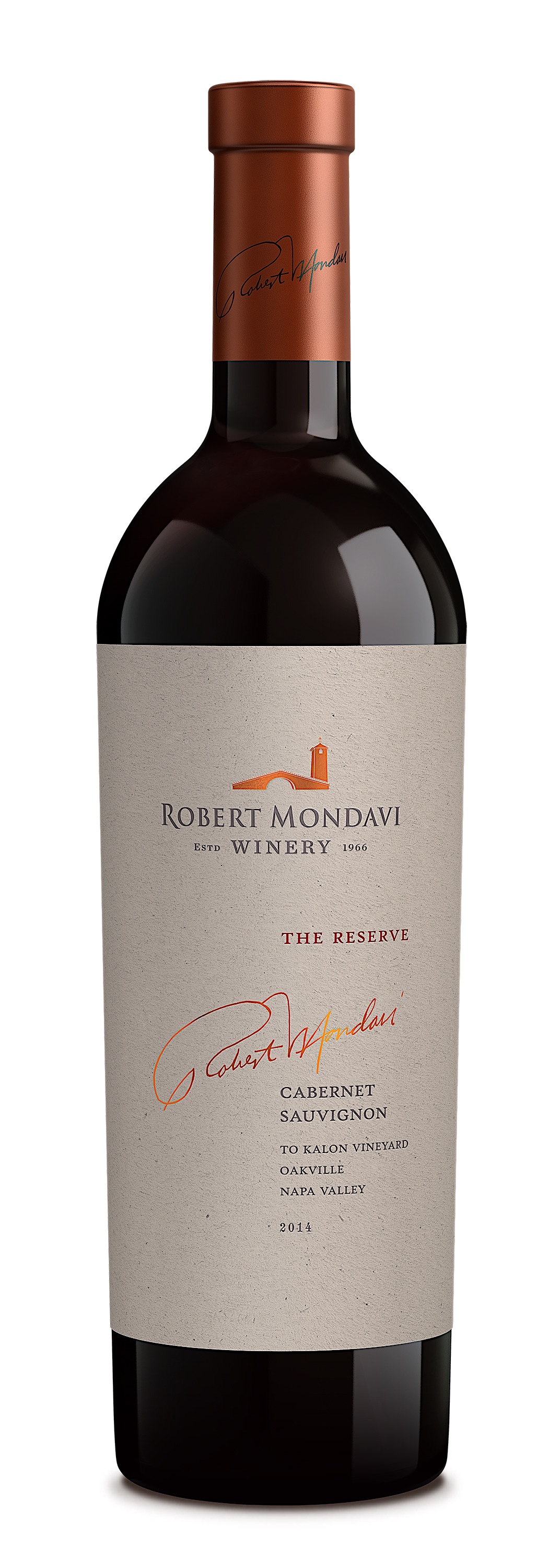 that home.
that home.
• 2005 Robert Mondavi Winery
Cabernet Sauvignon Reserve, To Kalon
Vineyard, Oakville, Napa Valley
• 1996 Robert Mondavi Winery
Cabernet Sauvignon Reserve, Napa
Valley
• 1980 Robert Mondavi Winery
Cabernet Sauvignon Reserve, Napa
Valley
• 1975 Robert Mondavi Winery
Cabernet Sauvignon Reserve, Napa
Valley
• 2015 Robert Mondavi Winery, The
Reserve Cabernet Sauvignon, To
Kalon Vineyard, Oakville, Napa Valley
Even the 40-plus year-old
1975 was thoroughly enjoyable to drink now.
Soft and resolved, with tastes of
roasted meats. Not even the brown rim
detracted from this fundamentally
different animal from the young To Kalons. I
wonder, in a world of irrigation
and replanting with different clones
post-phylloxera, whether the 2015 will be
the same in 2055 as the 1975 is now? I suspect
not, so hunt the auctions today
for 1975, 1980 and 1996.
❖❖❖
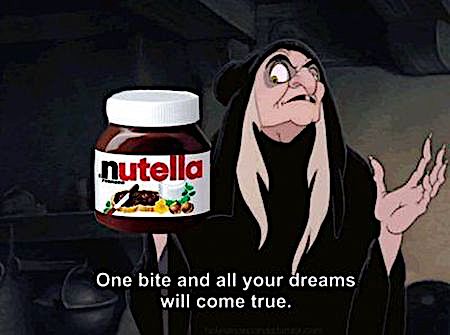
HANDS?
The makers of Nutella are hiring
60 "sensory
testers" to work in Italy, no
experience necessary. The tasters will begin on
September 30 with a three-month course in honing their
senses, with 40 of the group chosen to work two days a
week on tasting panels.
REALLY WEIRD
THINGS NO ONE ELSE HAS NOTICED.
“While I
wasn’t watching, mayo’s day had come and gone… Good ol’
mayo has become the Taylor Swift of condiments.”--Sandy Hingston, “The White Stuff,” Philadelphia Magazine.
❖❖❖
Wine
Column Sponsored by Banfi Vintners
SANGIOVESE
 Wine is a joy year-round but
in cooler weather one
grape varietal has really taken center stage in
my daily activities – that most Italian of
grapes, Sangiovese, and its ultimate expression
– Brunello di Montalcino.
Wine is a joy year-round but
in cooler weather one
grape varietal has really taken center stage in
my daily activities – that most Italian of
grapes, Sangiovese, and its ultimate expression
– Brunello di Montalcino.
From mid-September through mid-October,
the Sangiovese grown for our various styles of red
wines are be harvested, culminating with the top
selection for Brunello di Montalcino.
Second, cooler weather here means
it is time to start enjoying more red wines and
especially Sangiovese based wines. That
includes Banfi’s cru of Brunello, Poggio alle Mura,
literally the cream of the crop of our Sangiovese
vineyards. Alongside our Poggio alle Mura Brunello di
Montalcino, this year we introduced two more wines
from the cru Poggio alle Mura – a Rosso di Montalcino
and a Riserva of Brunello. Rosso is sort of like the
younger brother of Brunello, also made from 100%
Sangiovese grapes but usually a selection from younger
vines and the wine is aged only two years compared to
the four required for Brunello. The
Riserva, on the other hand, is an even more selective
harvest of Sangiovese, and ages for an additional year
before release.
What is so special about this cru
Poggio alle Mura?
Well, it is the result our over 30 years of
ongoing research at my family’s vineyard estate,
Castello Banfi.
When we first began planting our vines there in
the late 1970s studies from the University of Bordeaux
indicated which strains of many varietals we should
plant, based on the soil type and microclimate of each
vineyard. But
when it came to the region’s native Sangiovese, there
was only local lore, no scientific research. So we took
it upon ourselves to figure out this vine, and set off
on three decades of incredibly detailed research.
We started
with 600 apparent variations on Sangiovese, because it
is so susceptible to variations in weather and soil,
and narrowed that down to 160 truly genetically
different clones.
We planted a vineyard with two rows of each
type, made wine from each of them, and charted the
differences – remember, you only get one chance a year
to make wine, so this took time.
It took about ten years to get some
concrete results, though we continue to experiment
today and always will – you never stop learning in
science and nature!
Once we determined which were the best,
complementary clones that could be planted together to
make the best Brunello, we chose to plant them in what
we determined to be the optimal vineyard sites. Coincidentally,
the best soils and climate conditions are in the
slopes surrounding the medieval fortress today known
as Castello Banfi, known since Etruscan times as
Poggio alle Mura – the walled hilltop. Hence the
name of our most special “cru” of Brunello,
representing a synthesis between tradition and
innovation.
Though the focus of this study was
our Brunello, all of our Sangiovese-based wines,
including the super Tuscans SummuS, Cum Laude, and
Centine, benefitted from this work. And that’s
the third reason for celebrating Sangiovese this
month, for the range of wonderful reds that usher us
into autumn! One
wine in particular was inspired by our research – the
BelnerO, a Sangiovese dominant blend with what I like
to call a kiss of Cabernet and a whisper of Merlot. We grow the
grapes a little differently for BelnerO than for
Brunello, make the wine with less oak aging and
released it earlier from the winery, providing a
counterpoint to Brunello and a lovely terroir-driven
wine in its own right.
If you
know Italians, you know that by nature we are
multi-faceted, varying in mood, and always passionate. As a
nation, we span from the hot sunny beaches of Sicily
near the African coast to the rugged mountains and
Alpine ski slopes of Trentino-Alto Adige in the north. Sangiovese
is grown in almost all of Italy’s regions and reflects
the unique nature of each; it is most famous
(rightfully so) in Tuscany, yet even there it reflects
the nuances of each hilltop, valley and subzone. It has
something a little different to say in Brunello than
Chianti, Morellino than Vino Nobile di Montepulciano,
Rosso di Montalcino than Super Tuscan blends.
Here is a smattering of
Sangiovese-based wines that you may wish to get to
know better, reflecting a spectrum that appeals to
every occasion, every taste, and every budget. We can
assure you that the conversation will never become
boring. 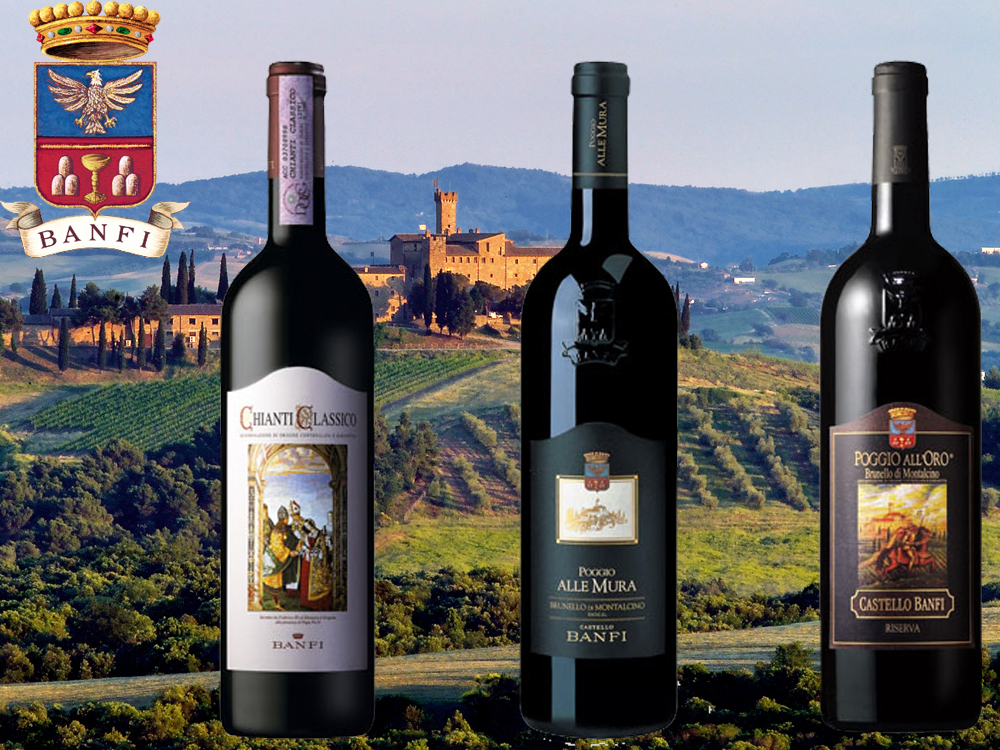
Recommendations for Celebrating
Sangiovese
BelnerO Proprietor’s Reserve Sangiovese
– A refined
cuvée of noble red grapes perfected by our pioneering
clonal research. This dark beauty, BelnerO, is
produced at our innovative winery, chosen 11
consecutive years as Italy’s Premier Vineyard Estate.
Fermented in our patented temperature controlled
French oak and aged approximately 2 additional years.
Unfiltered, and Nitrogen bottled to minimize sulfites.
Castello Banfi Brunello di Montalcino –
Rich, round, velvety and intensely
aromatic, with flavor hints of licorice, cherry, and
spices. Brunello di Montalcino possesses an intense
ruby-red color, and a depth, complexity and opulence
that is softened by an elegant, lingering aftertaste.
Unfiltered after 1998 vintage.
Castello Banfi Rosso di Montalcino – Brunello's "younger brother," produced
from select Sangiovese grapes and aged in barrique for
10 to 12 months. Deep ruby-red, elegant, vibrant,
well-balanced and stylish with a dry velvety
finish.
Poggio all’Oro Brunello di Montalcino
Riserva – A single vineyard selection of our most
historically outstanding Sangiovese, aged five years
before release, the additional year more than that
required of Brunello including 6 months in barrel and
6 months more in bottle to grant its “Riserva”
designation. Incredible
elegance and harmony. Intense with lots of fruit and
subtle wood influence. Round, complete, well balanced
with hints of chocolate and berries. Unfiltered after
1998.
Poggio alle Mura – The first tangible result of years of
intensive clonal research on Montalcino’s native
Sangiovese grape.
Estate bottled from the splendidly sun drenched
vineyards surrounding the medieval Castello from which
it takes its name.
The Brunello
di Montalcino is seductive, silky and smoky. Deep ruby
in color with an expressive bouquet of violets, fruits
and berries as well as cigar box, cedar and exotic
spices. The Rosso
di Montalcino is also intense ruby red. The bouquet
is fresh and fruity with typical varietal notes of
cherry and blackberry, enriched by more complex hints
of licorice, tobacco and hazelnut. It is full
bodied, yet with a soft structure, and a surprisingly
long finish. The Poggio alle Mura Brunello di Montalcino
Riserva is deep ruby red with garnet
reflections and a rich, ample bouquet that hints of
prune jam, coffee, cacao and a light balsamic note. It is full
and powerful, with ripe and gentle tannins that make
it velvety and harmonious; this wine is supported by a
pleasing minerality that to me speaks soundly of that
special hillside in southern Montalcino.
SummuS – A wine of towering elegance, SummuS is an
extraordinary blend of Sangiovese which contributes
body; Cabernet Sauvignon for fruit and structure; and
Syrah for elegance, character and a fruity bouquet. An elegant,
complex and harmonious red wine.
Cum Laude – A complex and elegant red which graduated
“With Honors,” characterized by aromas of juicy
berries and fresh spices.
Centine – A Cuvee that is more than half
Sangiovese, the balanced consisting of equal parts of
Cabernet Sauvignon and Merlot. Vinified in
a firm, round style that easily accompanies a wide
range of dishes, this is a smooth and fragrantly
satisfying wine with international character, and a
perennial favorite at my own dinner table.
Banfi Chianti Superiore – The “Superiore” designation signifies
stricter government regulations regarding production
and aging requirements, as compared to regular
Chianti. An
intense ruby red wine with fruit forward aromas and
floral notes. This
is a round wine with well-balanced acidity and fruit.
Banfi Chianti Classico – An enduring classic: alluring
bouquet of black fruit and violets; rich flavors of
cherry and leather; supple tannins and good acidity
for dining.
Banfi Chianti Classico Riserva – Produced from select grapes grown in the
"Classico" region of Chianti, this dry, fruity and
well-balanced red has a full bouquet reminiscent of
violets.
Fonte alla Selva Chianti Classico – This is our newest entry into the Chianti
arena, coming from a 99 acre estate in Castellina, the
heart of the Chianti Classico region. The wine is
a captivating mauve red that smells of cherry, plum
and blackberry with hints of spice. It is
round, full and balanced with very good
acidity.
Col di Sasso – Sangiovese and Cabernet Sauvignon. Luscious,
complex and soft with persistent notes of fruit and
great Italian style structure.
Any of John Mariani's books below may be ordered from amazon.com.
 The Hound in Heaven
(21st Century Lion Books) is a novella, and
for anyone who loves dogs, Christmas, romance,
inspiration, even the supernatural, I hope you'll find
this to be a treasured favorite. The story
concerns how, after a New England teacher, his wife and
their two daughters adopt a stray puppy found in their
barn in northern Maine, their lives seem full of promise.
But when tragedy strikes, their wonderful dog Lazarus and
the spirit of Christmas are the only things that may bring
his master back from the edge of despair.
The Hound in Heaven
(21st Century Lion Books) is a novella, and
for anyone who loves dogs, Christmas, romance,
inspiration, even the supernatural, I hope you'll find
this to be a treasured favorite. The story
concerns how, after a New England teacher, his wife and
their two daughters adopt a stray puppy found in their
barn in northern Maine, their lives seem full of promise.
But when tragedy strikes, their wonderful dog Lazarus and
the spirit of Christmas are the only things that may bring
his master back from the edge of despair. WATCH THE VIDEO!
“What a huge surprise turn this story took! I was completely stunned! I truly enjoyed this book and its message.” – Actress Ali MacGraw
“He had me at Page One. The amount of heart, human insight, soul searching, and deft literary strength that John Mariani pours into this airtight novella is vertigo-inducing. Perhaps ‘wow’ would be the best comment.” – James Dalessandro, author of Bohemian Heart and 1906.
“John Mariani’s Hound in Heaven starts with a well-painted portrayal of an American family, along with the requisite dog. A surprise event flips the action of the novel and captures us for a voyage leading to a hopeful and heart-warming message. A page turning, one sitting read, it’s the perfect antidote for the winter and promotion of holiday celebration.” – Ann Pearlman, author of The Christmas Cookie Club and A Gift for my Sister.
“John Mariani’s concise, achingly beautiful novella pulls a literary rabbit out of a hat – a mash-up of the cosmic and the intimate, the tragic and the heart-warming – a Christmas tale for all ages, and all faiths. Read it to your children, read it to yourself… but read it. Early and often. Highly recommended.” – Jay Bonansinga, New York Times bestselling author of Pinkerton’s War, The Sinking of The Eastland, and The Walking Dead: The Road To Woodbury.
“Amazing things happen when you open your heart to an animal. The Hound in Heaven delivers a powerful story of healing that is forged in the spiritual relationship between a man and his best friend. The book brings a message of hope that can enrich our images of family, love, and loss.” – Dr. Barbara Royal, author of The Royal Treatment.
 |
The Encyclopedia of American Food and Drink by John F. Mariani (Bloomsbury USA, $35) Modesty forbids me to praise my own new book, but let me proudly say that it is an extensive revision of the 4th edition that appeared more than a decade ago, before locavores, molecular cuisine, modernist cuisine, the Food Network and so much more, now included. Word origins have been completely updated, as have per capita consumption and production stats. Most important, for the first time since publication in the 1980s, the book includes more than 100 biographies of Americans who have changed the way we cook, eat and drink -- from Fannie Farmer and Julia Child to Robert Mondavi and Thomas Keller. "This book is amazing! It has entries for everything from `abalone' to `zwieback,' plus more than 500 recipes for classic American dishes and drinks."--Devra First, The Boston Globe. "Much needed in any kitchen library."--Bon Appetit. |
"Eating Italian will never be the same after reading John Mariani's entertaining and savory gastronomical history of the cuisine of Italy and how it won over appetites worldwide. . . . This book is such a tasteful narrative that it will literally make you hungry for Italian food and arouse your appetite for gastronomical history."--Don Oldenburg, USA Today. "Italian
restaurants--some good, some glitzy--far
outnumber their French rivals. Many of
these establishments are zestfully described
in How Italian Food Conquered the World, an
entertaining and fact-filled chronicle by
food-and-wine correspondent John F.
Mariani."--Aram Bakshian Jr., Wall Street
Journal.
"Equal parts
history, sociology, gastronomy, and just
plain fun, How Italian Food Conquered the
World tells the captivating and delicious
story of the (let's face it) everybody's
favorite cuisine with clarity, verve and
more than one surprise."--Colman Andrews,
editorial director of The Daily
Meal.com. "A fantastic and fascinating
read, covering everything from the influence
of Venice's spice trade to the impact of
Italian immigrants in America and the
evolution of alta cucina. This book will
serve as a terrific resource to anyone
interested in the real story of Italian
food."--Mary Ann Esposito, host of PBS-TV's
Ciao
Italia. "John Mariani has written the
definitive history of how Italians won their
way into our hearts, minds, and
stomachs. It's a story of pleasure over
pomp and taste over technique."--Danny Meyer,
owner of NYC restaurants Union Square
Cafe, The Modern, and Maialino.
|
 |
 |
 |
 |
 |
 |
 |
 |
 Everett Potter's Travel Report:
Everett Potter's Travel Report: 
 Eating Las Vegas
JOHN CURTAS has been covering the Las Vegas
food and restaurant scene since 1995. He is
the co-author of EATING LAS VEGAS – The 50
Essential Restaurants (as well as
the author of the Eating Las Vegas web site: www.eatinglasvegas.
He can also be seen every Friday morning as
the “resident foodie” for Wake Up With the
Wagners on KSNV TV (NBC) Channel 3 in
Las Vegas.
Eating Las Vegas
JOHN CURTAS has been covering the Las Vegas
food and restaurant scene since 1995. He is
the co-author of EATING LAS VEGAS – The 50
Essential Restaurants (as well as
the author of the Eating Las Vegas web site: www.eatinglasvegas.
He can also be seen every Friday morning as
the “resident foodie” for Wake Up With the
Wagners on KSNV TV (NBC) Channel 3 in
Las Vegas.
MARIANI'S VIRTUAL GOURMET
NEWSLETTER is published weekly. Publisher: John Mariani. Editor: Walter Bagley. Contributing Writers: Christopher Mariani,
Robert Mariani, Misha Mariani, John A. Curtas, Gerry Dawes, Geoff Kalish,
and Brian Freedman. Contributing
Photographer: Galina Dargery. Technical
Advisor: Gerry
McLoughlin.
If you wish to subscribe to this
newsletter, please click here: http://www.johnmariani.com/subscribe/index.html
© copyright John Mariani 2017

